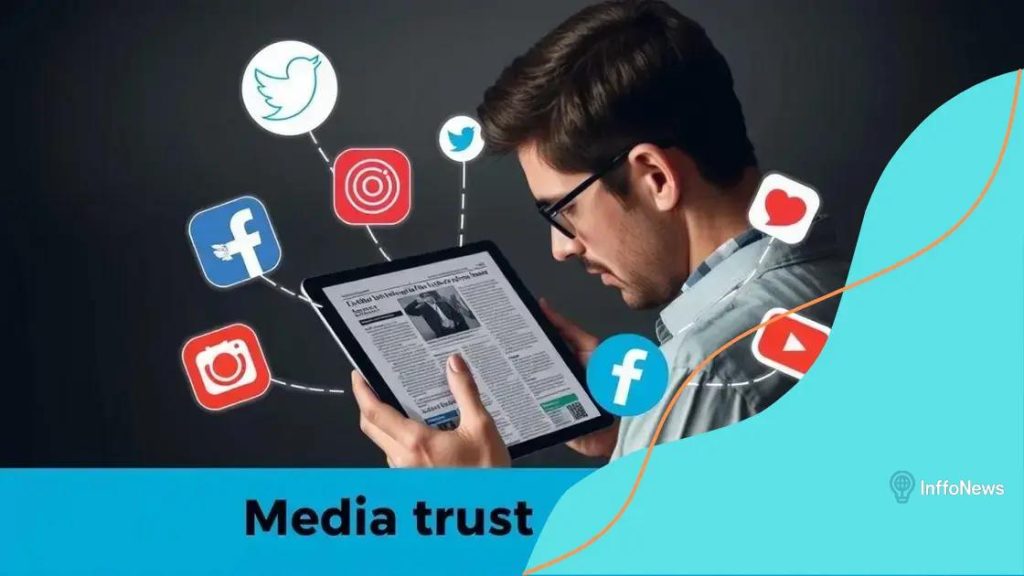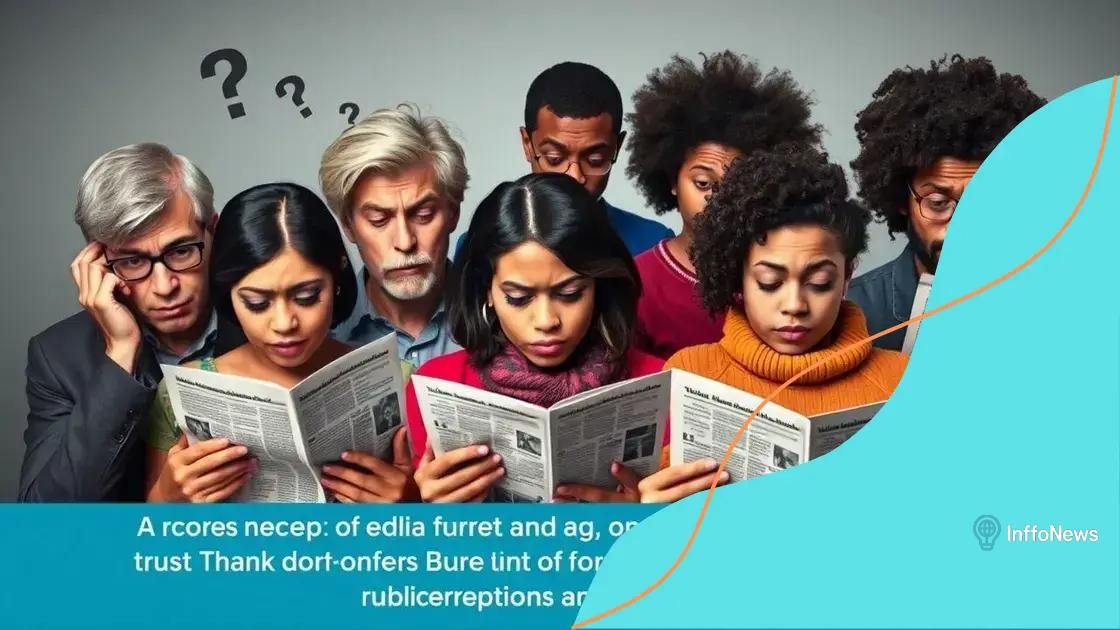Media trust challenges: navigating the new landscape

Anúncios
Media trust challenges arise from the spread of misinformation and skepticism, necessitating strategies like transparency, media literacy, community engagement, and collaboration to restore public confidence.
Media trust challenges have become increasingly pertinent in our digital age. As misinformation proliferates, many question the credibility of news sources. What can be done to ensure reliable information prevails?
Anúncios
Understanding the rise of media trust challenges
Understanding the challenges of media trust is crucial in today’s world. With the rise of social media, information spreads faster than ever. However, the accuracy of that information often comes into question, leading to confusion among audiences.
This situation has led to a growing mistrust in various media platforms. Questions about the reliability of news sources are at an all-time high. It’s important to recognize why this shift occurs and how it affects society.
The Role of Misinformation
Misinformation can come from various sources, including:
Anúncios
- Social media platforms that allow unverified content to spread.
- Political agendas that distort facts for influence.
- Echo chambers that reinforce false information.
As a result, people struggle to discern credible news. Understanding these influences helps individuals navigate their media consumption more wisely.
Vulnerabilities in Media Trust
People are more vulnerable to believing fake news when they are not critical of the information they consume. These vulnerabilities include:
- Low media literacy among the public.
- High emotional reactions to sensational news.
- Trust in familiar sources over verified facts.
All these factors contribute to an atmosphere where media trust challenges thrive. Being aware of these issues allows consumers to approach news with a more scrutinizing mindset.
As we continue to witness these media trust challenges, it becomes essential to foster discussions around media literacy. Encouraging critical thinking in consuming information is vital. Individuals must learn to evaluate sources, cross-check facts, and recognize bias. This knowledge empowers them to make informed decisions and enhances their overall understanding of the news landscape.
The role of social media in misinformation
The role of social media in spreading misinformation cannot be ignored. With billions of users, these platforms allow rapid sharing of content, but not all of it is accurate. Many people rely on social media as their main source of news. This has significant implications for trust in media.
Often, misinformation spreads because it is sensational or aligns with a person’s beliefs. This can amplify false narratives, making them seem like truth. The ease of sharing and liking allows misleading posts to gain traction and reach wider audiences.
Factors Contributing to Misinformation
Several factors contribute to the spread of misinformation on social media:
- The viral nature of shocking headlines.
- Algorithms that prioritize engagement over accuracy.
- Lack of fact-checking tools available to users.
These elements create an environment where misinformation can thrive. Users may not question the validity of what they see, increasing the likelihood of sharing incorrect information further.
Combating Misinformation
To tackle misinformation, social media platforms are implementing various strategies. Some include:
- Flagging or labeling potentially false content.
- Providing links to fact-checking resources.
- Encouraging users to verify information before sharing.
Despite these efforts, many people still fall victim to misleading information. It’s essential for individuals to develop critical thinking skills and question what they consume online. Engaging in conversations about media literacy can also support a more informed public.
As users become more aware of the influences behind social media, they can make better choices regarding the information they share. A collective effort to promote accurate information can help rebuild trust in the media landscape.
Impact on public perception and democracy

The impact of media trust challenges on public perception and democracy is significant. As misinformation spreads, it can distort the way people view important issues. When individuals cannot trust the media, they may turn to less reliable sources or social media, which can lead to a more divided public.
This division can result in weaker democratic processes. Voters may rely on skewed information that reinforces their biases, making it harder for them to engage in constructive dialogue. Furthermore, a lack of trust in media can reduce voter turnout, as people feel disillusioned about the information presented to them.
Effects on Public Engagement
The decline in media trust affects how the public engages with news and opinions:
- Increased skepticism towards traditional news sources.
- Growing reliance on alternative media, which may not always prioritize accuracy.
- Difficulty in finding common ground on key issues.
As more individuals question what to believe, the overall strength of democracy can diminish. Informed citizens are essential for a healthy democratic society. When individuals base their opinions on unreliable information, they lose the ability to make well-informed decisions during elections.
The Role of Critical Thinking
Promoting critical thinking is essential to combat the negative effects of media distrust. Encouraging education about media literacy can help people assess information more effectively. Here are some ways to foster critical thinking:
- Teach individuals how to fact-check sources and claims.
- Encourage discussions about media bias and motivations.
- Promote awareness of the effects of echo chambers.
By enhancing critical thinking skills, the public can better navigate misinformation and its effects on society. Public perception plays a crucial role in shaping the direction of democracy, and addressing media trust challenges is vital for maintaining an informed citizenry.
Strategies to combat media distrust
Strategies to combat media distrust are essential in restoring public confidence in news sources. Many individuals feel overwhelmed by the amount of information available, leading to skepticism about what is true. By implementing effective strategies, we can help bridge this gap.
One approach is to promote transparency among media organizations. When news outlets openly share their sources, methods, and funding, it fosters trust. Accountability is critical in maintaining credibility in journalism.
Encouraging Media Literacy
Educating the public about media literacy is vital. Here are some strategies to enhance media understanding:
- Workshops and courses on how to identify credible sources.
- Encouraging critical thinking when consuming news.
- Teaching fact-checking skills to evaluate claims.
By improving media literacy, individuals will be better equipped to discern fact from fiction, cultivating a generation of informed consumers.
Engaging in Community Discussions
Community engagement plays a crucial role in combating media distrust. Encouraging open discussions about news topics can foster understanding. Some ideas include:
- Hosting town hall meetings to discuss local news.
- Creating forums for sharing diverse perspectives.
- Utilizing social media to facilitate constructive conversations.
Building a community around honest dialogue encourages people to seek out trusted information sources. This connection can help rebuild faith in the media.
Collaboration with Fact-Checkers
Media organizations should collaborate with fact-checking organizations to verify the information presented. Fact-checkers can provide unbiased analysis of complex issues. By partnering with these organizations, news outlets can:
- Improve the accuracy of the information shared.
- Offer corrections as needed to maintain integrity.
- Demonstrate a commitment to truth and accountability.
As media organizations strengthen their credibility, the public’s trust will likely follow. By taking practical steps and working together, we can combat media distrust effectively and foster a more informed society.
Restoring trust: initiatives and future directions
Restoring trust in the media is essential for a well-informed society. With increasing skepticism, various initiatives are emerging to address media trust challenges. These efforts aim to rebuild confidence among the public.
One significant initiative is fostering collaboration between various media organizations. By working together, these entities can share best practices and strengthen their credibility. Transparency becomes a key component, as audiences appreciate when news outlets are clear about their sourcing and editorial processes.
Promoting Accurate Reporting
Another important direction is the emphasis on accurate reporting. Media outlets are being encouraged to prioritize fact-checking and ensure the information they present is verified. Some promising strategies include:
- Implementing more rigorous editorial standards.
- Establishing partnerships with fact-checking organizations.
- Creating training programs for journalists on ethical reporting.
These approaches help enhance the quality of news, leading to greater public trust overall.
Engagement with the Audience
Engaging directly with audiences is another crucial initiative. News organizations that listen to their viewers and readers can better understand their concerns. Feedback mechanisms can include:
- Surveys to gauge audience trust.
- Open forums for discussing news coverage.
- Regular interaction on social media platforms.
By actively involving the community, media outlets demonstrate their commitment to addressing public concerns and building a stronger relationship.
Future Directions for Trust Restoration
Future efforts to restore trust may include the integration of technology and innovation. Using AI and analytics can improve the delivery of accurate information. It can also help identify and combat misinformation before it spreads widely. Furthermore, fostering partnerships with educational institutions can promote media literacy among younger generations. Teaching critical thinking skills ensures that future citizens are better equipped to navigate complex media landscapes. Restoring trust requires ongoing collaboration, commitment to accuracy, and community engagement.
FAQ – Frequently Asked Questions about Restoring Trust in Media
What are key strategies to restore trust in the media?
Key strategies include promoting transparency, enhancing media literacy, engaging with the community, and collaborating with fact-checkers.
How can media literacy help combat misinformation?
Media literacy teaches individuals how to critically analyze and verify information, empowering them to recognize and avoid misinformation.
Why is community engagement important for media trust?
Community engagement fosters open discussions and feedback, helping media organizations understand public concerns and build stronger relationships.
What role does technology play in restoring media trust?
Technology can improve the accuracy of information delivery and help identify and combat misinformation, supporting overall media credibility.





